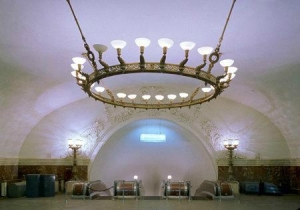Moskau +7-495-505-63-25
Sankt Petersburg +7-812-309-57-60
Excursions with Moscow Metro
Moscow Metro

For the first time the idea of constructing the underground railroad in Moscow appeared at the beginning of the 20th century, when the city population exceeded one million. The project of metro construction presented in 1902 to Moscow Duma implied that some metro lines would pass overland, and the trains would run by the tunnels and platforms from the Central Railway Station that was supposed to be nearby the Red Square. The project was remarkable for fresh engineering ideas, but Moscow Duma rejected it, since the owners of tram company indignantly opposed the project.
At the time of Soviet power the idea of metro construction reappeared. The first, experiment tunnel was built in 1931, and in 1932 the construction works started. It took 21 percent of Moscow budget to keep the works going. The plans were grandiose, but there was not enough hardware, so propaganda and people's enthusiasm were the only things that could help. Young people from all over the Soviet Union were invited to participate in metro construction. Miners of Donbass, concrete makers of Dneprostroy, and Moscow members of Komsomol took part in metro building. The history of metro construction is reflected in the movie «The volunteers».
The first line of Moscow metro was opened on May 15, 1935, at 7 a.m. Some Muscovites were waiting for metro opening all night long, as they wanted to be the first ones to try the novelty.
Some stations were designed by outstanding Soviet architects. Among them was A. Shchusev, the author of the Mausoleum in Moscow. The grand stations looked like palaces. They were decorated with stained-glass windows, paintings, majolica, and even sculptural groups. Stations were faced with marble, granite, and other various stones.
Soon after the opening, the metro became the inseparable part of Moscow. During World War II, the stations of the metro served as air-raid shelters to hundreds of thousands of Muscovites. Some stations housed military and state institutes. For example, the Kirovskaya station housed the departments of the Red Army General Staff. Trains did not stop there, and the platform was separated from the railroad by high plywood partition. Even in the days of the war the construction works did not stop.
After the end of the war new stations were less magnificent, since ferroconcrete items and cheaper materials were used. Unfortunately, striving for economy made some stations look ordinary. Only in the 1970-1980s the idea of decorating each station in unique way reappeared.
Nowadays Moscow metro takes the first place in functioning capacity in the world. The general length of the metro is over 265 kilometers, and since early morning till late night 170 stations function.
Moscow metro grows together with the city. By 2010 the city administration plans to put into operation over 80 kilometers of new lines that would connect the center of the city with its furthest outskirts.
Hotels in der Nähe
Marco Polo Presnja
Spiridonjevsky Str., 9
Das Marco Polo Presenja ist ein komfortables 4-Sterne-Hotel, gelegen im Herzen von Moskau, nur einen Spaziergang vom
ab 0
pro Nacht
Budapest
2/18 Petrovskiye Linii St.
The Budapest Hotel is located in the historical district of Moscow, close to the main business and cultural centers
ab 0
pro Nacht
Golden Apple
11 Malaya Dmitrovka St.
The five-star Golden Apple Hotel is perfectly located in the centre of Moscow, in several minutes` walk from the
ab 0
pro Nacht
Peter I
Neglinnaya Str., 17
Das Peter I Hotel liegt im Stadtzentrum, in Moskau, nur 100 Meter vom Bolshoi Theater und 500 Meter von Rotem Platz
ab 0
pro Nacht
Peking
Bolshaya Sadovaya Str., 5
Das Hotel liegt gleich in der Nähe der U-Bahnhaltestelle Majakovskaja und dem Bahnhof Belorusski und der Rote Platz
ab 58.69
pro Nacht
Sehenswürdigkeiten von Moskau
- Monuments
- Attractions











